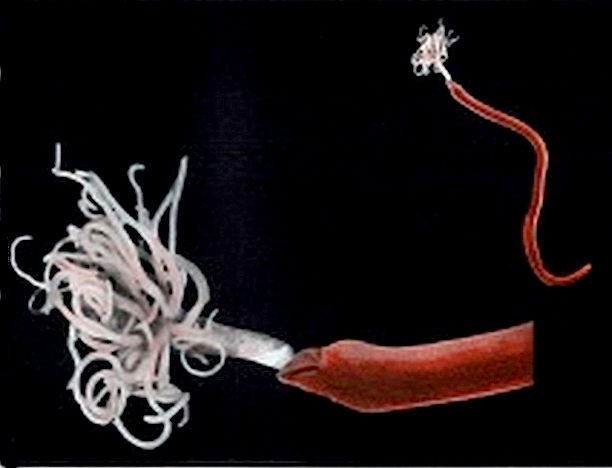Ribbon worms (Phylum Nemertea) are an unfamiliar group of invertebrates to aquarists and the general public alike. Despite their occasionally immense size, this unique phylum of animal life is seldom on anyone’s radar. Which is why it came as a surprise to find a video of one of these creatures taking the internet by storm this week.
[Above image from Dakin & Fordham, 1936]
https://www.youtube.com/watch?v=mxtKxlR5yqM
In a short clip, the worm in question can be seen to extrude what appears to be a milky-white, ramifying substance. At first glance, it seems to be some kind of mucusy defensive secretion, but the truth is actually far stranger. It’s a highly modified eversible proboscis, whose structure is unique to this particular genus of nemertean, Gorgonorhynchus. All ribbon worms possess a proboscis, which is typically either a long cylinder covered in papillae or may instead have a sharp venomous stylet at the end. A handful of other genera (Dendrorhynchus, Polybranchiorhynchus, Panorhynchus) likewise possess a branched proboscis, but in these groups the main branch of the proboscis has only short side branches, giving it an appearance analogous to the shape of a bird’s feather.

All of these genera are species-poor and (with the exception of a single deepwater Antarctic species) can be found in shallow, muddy marine habitats. Despite there being little published on the life history of Gorgonorhynchus, we can make some inferences based on its ecological preferences and unique morphology. Comparable feeding structures can be seen in Spaghetti Worms (in the distantly related Phylum Annelida), which use their panoply of feeding tentacles to sweep the ocean’s benthos for organic particles.
[youtube]https://www.youtube.com/watch?v=qT2x9YuowqU[/youtube]
Perhaps a better example can be found in the Medusa Worms, which, despite the similar common name, are actually highly modified Sea Cucumbers (Phylum Echinodermata). So is Gorgonorhynchus feeding in a similar manner? If so, this might make for an interesting and useful addition to a reef aquarium. The great disadvantage Medusa Worms have is that their incredibly delicate bodies and great physical length make them unsuitable for most aquaria. The smaller and apparently more robust Gorgon Worm could thus fill an important niche within captive marine ecosystems that is currently underutilized. But the possibility (likelihood?) also exists that this dendritic proboscis is instead used to entrap prey, in a manner similar to the nudibranch Melibe… in which case this worm would probably be a terrible, terrible thing to add to an aquarium. Remember that the majority of Ribbon worms are carnivorous.
There are only two described species of Gorgonorhynchus: the Pacific G. repens and the Atlantic G. bermudensis, though this latter taxon may in fact be synonymous with the Pacific form. This is a far wider biogeographic range compared to related ribbon worm genera, and hints at their potential abundance in regions with aquarium collection. Anecdotal reports suggest these creatures can be found in densities of a worm per square meter, and, in the video making the internet rounds, specimens were common enough to be collected as fishing bait. There are undoubtedly at least a few intrepid aquarists (e.g. me) willing and wanting to keep this fascinating creature in an aquarium… if only someone would collect and export them.



